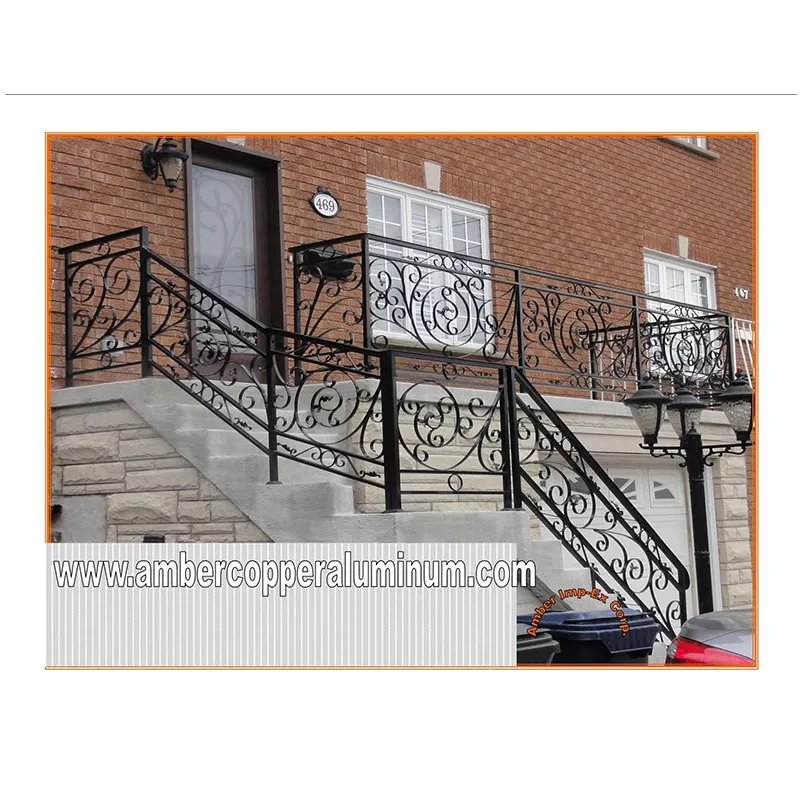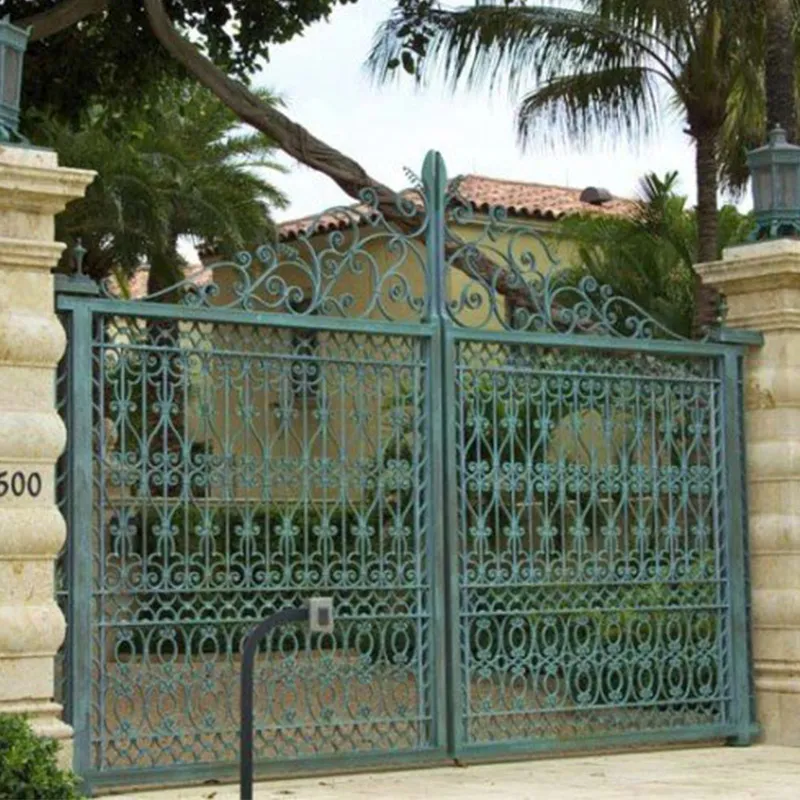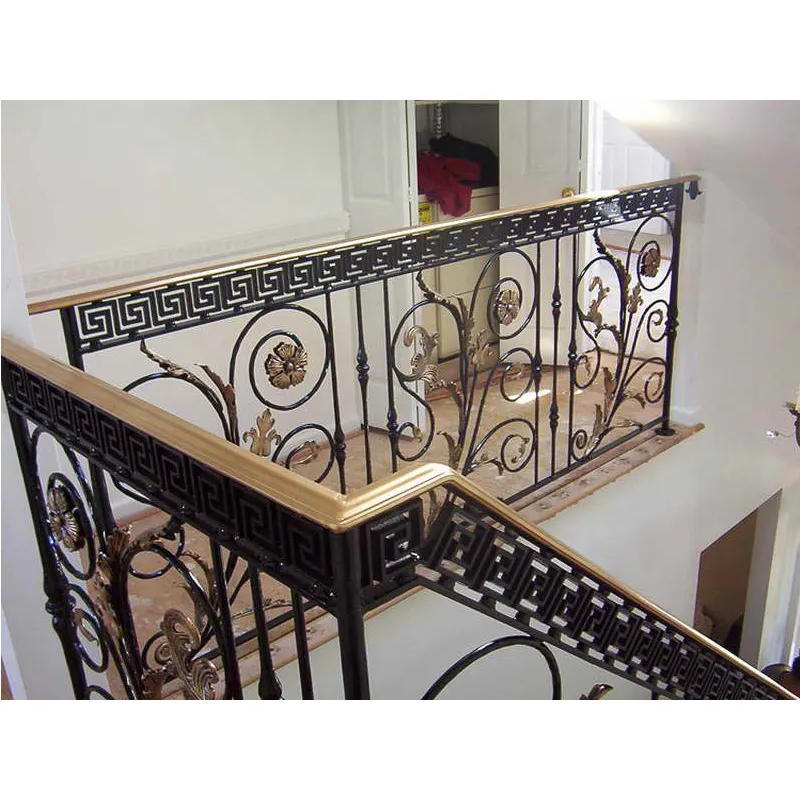
Elevating Design and Durability: The Critical Role of Decorative Wrought Iron Parts in Modern Construction and Architecture
In the intricate world of architecture, construction, and specialized industrial applications, the demand for components that offer both aesthetic elegance and robust functionality is paramount. Decorative wrought iron parts stand as a testament to this duality, seamlessly blending timeless artistry with engineering integrity. These components, often intricate in design yet incredibly strong, are crucial for enhancing the visual appeal and structural longevity of various installations, from historical restorations to contemporary builds. The market for these specialized parts is experiencing a notable resurgence, driven by a renewed appreciation for bespoke craftsmanship and the superior performance characteristics of wrought iron compared to more conventional materials like cast iron or steel alloys in certain applications. Current industry trends highlight a significant pivot towards custom fabrication and the integration of advanced manufacturing techniques to produce parts that meet rigorous project specifications while offering unparalleled design flexibility. Furthermore, there is an increasing emphasis on sustainable production practices and the longevity of materials, areas where wrought iron, with its inherent durability and potential for recycling, excels. The versatility of these parts extends beyond purely ornamental uses, serving critical structural functions in high-traffic areas where durability and resistance to wear are essential. Their application scope is remarkably broad, spanning residential, commercial, and industrial sectors. In residential projects, they are widely used in custom gates, elaborate railings, balustrades, and intricate window grilles, adding significant curb appeal and property value. Commercially, they adorn high-end hotels, corporate campuses, and public spaces, contributing to a distinctive architectural identity. Industrially, specialized forged components might be integrated into machinery or infrastructure where unique shapes, strength, and corrosion resistance are required, often working alongside or as components of larger systems such as fluid conveyance in water supply and drainage networks, or structural elements in certain light-duty metallurgical applications. The longevity of these components, often exceeding several decades with minimal maintenance, positions them as a cost-effective long-term investment. This inherent durability also contributes to their sustainability profile, reducing the frequency of replacement and minimizing resource consumption. Understanding the precise manufacturing processes, material science, and quality assurance protocols behind these parts is crucial for engineers, architects, and procurement professionals seeking to specify optimal solutions for their complex projects.
Precision Engineering: The Manufacturing Process of Decorative Wrought Iron Parts
The creation of high-quality decorative wrought iron parts is a sophisticated multi-stage process that combines traditional craftsmanship with modern technological advancements. The journey begins with the careful selection of raw materials, primarily low-carbon steel, often specifically chosen for its malleability and weldability, crucial properties for the forging and forming processes unique to wrought iron. Unlike cast iron, which is brittle and non-malleable, wrought iron is fibrous and ductile, allowing it to be hot-worked and shaped. The primary manufacturing processes include traditional forging, where the metal is heated to a high temperature (typically 900-1200°C) and then hammered, bent, and twisted into desired shapes by skilled artisans or automated machinery. This hot-working refines the grain structure, enhancing the material's strength and toughness. Complementing traditional forging, modern techniques such as CNC machining are employed for precision cutting, drilling, and finishing, particularly for intricate designs or components requiring tight dimensional tolerances. Laser cutting, plasma cutting, and waterjet cutting are also utilized for complex profiles and patterns, ensuring accuracy and minimizing material waste. Following the primary shaping, secondary processes such as welding, grinding, and polishing are meticulously applied to achieve the desired finish and structural integrity. Welding, often TIG or MIG welding, is crucial for joining multiple wrought iron components to form larger assemblies, ensuring strong, seamless connections. Surface treatments, including galvanization, powder coating, or specialized paint applications, are then applied to enhance corrosion resistance and aesthetic appeal, extending the service life of the components, particularly in outdoor or corrosive environments like those found in coastal regions or industrial settings where exposure to chemicals is possible. Throughout the entire manufacturing cycle, stringent quality control measures are implemented. This includes raw material inspection, in-process checks at each forging and machining stage, and final product verification. Compliance with international standards such as ISO 9001 for quality management, ANSI (American National Standards Institute) for product performance, and ASTM International (American Society for Testing and Materials) for material specifications (e.g., ASTM A848 for wrought iron) is non-negotiable, ensuring that each part meets or exceeds industry benchmarks for durability, structural integrity, and finish quality.

Fig 1: Illustrative manufacturing stages of decorative wrought iron components.
The meticulous attention to detail at every stage of production contributes to the exceptional longevity and performance of ornamental railing parts and other wrought iron elements. For instance, in petrochemical plants, where structural integrity under fluctuating temperatures and exposure to corrosive agents is critical, properly treated wrought iron elements can provide superior long-term stability. Similarly, in large-scale metallurgical facilities, robust and precisely engineered wrought iron structures might be employed in non-critical decorative or support roles where their inherent strength and resistance to fatigue are beneficial. The design flexibility inherent in the forging process allows for highly customized solutions, catering to unique architectural visions or complex industrial requirements. This bespoke capability, combined with adherence to rigorous testing and certification protocols (e.g., tensile strength tests, impact resistance, and coating thickness measurements), ensures that the final product is not merely decorative but also a high-performance component engineered for specific demands, offering significant advantages in terms of reduced maintenance and extended operational life compared to less durable alternatives. High-quality decorative wrought iron parts are rigorously tested to ensure optimal performance.
Technical Specifications and Performance Metrics for Decorative Wrought Iron Parts
Understanding the technical specifications of decorative wrought iron parts is fundamental for architects, engineers, and procurement specialists to ensure optimal material selection and application. While "wrought iron" historically referred to nearly pure iron, modern interpretations often encompass low-carbon steel alloys specifically chosen and processed to replicate the desirable characteristics of traditional wrought iron—namely, its excellent malleability, ductility, and weldability. Key parameters evaluated include tensile strength, yield strength, hardness, and corrosion resistance, all critical for determining the structural integrity and longevity of components in various environments. For example, the typical tensile strength for modern wrought iron-like low-carbon steel used in decorative applications ranges from 350 to 450 MPa (megapascals), with a yield strength generally between 200 and 300 MPa. Its inherent ductility allows for significant deformation before fracture, making it resistant to sudden failures and ideal for complex designs that undergo bending or twisting during installation or use. The hardness, often measured on the Brinell scale (HB), typically falls within 90-130 HB, indicating a good balance of durability and workability. Furthermore, the ability to apply various protective coatings significantly enhances the inherent corrosion resistance of the base material. Hot-dip galvanization, for instance, provides a sacrificial zinc layer that can extend the service life of outdoor components by decades, especially in aggressive environments such as coastal areas or urban settings with high pollution. The dimensional accuracy and surface finish are also crucial, particularly for components that require precise fitment or are exposed to public view. Advanced manufacturing techniques like CNC machining ensure tolerances down to ±0.05 mm for critical dimensions, and surface finishes can be tailored from brushed satin to highly polished, meeting specific aesthetic and functional demands. Below is a representative table outlining typical parameters for high-quality decorative wrought iron components, providing a benchmark for performance expectations and quality assurance in demanding B2B applications.
| Parameter | Typical Value Range | Standard (Example) | Significance |
|---|---|---|---|
| Material Composition | Low Carbon Steel (e.g., C<0.15%, Mn<0.6%, Si<0.3%) | ASTM A36 / Q235B (for base steel) | Ensures ductility, weldability, and formability suitable for forging. |
| Tensile Strength (UTS) | 350 - 450 MPa | ASTM A848 (for wrought iron) / ASTM A36 | Maximum stress material can withstand before breaking. Indicates load-bearing capacity. |
| Yield Strength (YS) | 200 - 300 MPa | ASTM A848 / ASTM A36 | Stress at which material begins to deform permanently. Crucial for structural integrity. |
| Elongation at Break | Min. 20% (in 50mm) | ASTM A848 / ASTM A36 | Measure of ductility; resistance to brittle fracture under stress. |
| Hardness (Brinell) | 90 - 130 HB | ASTM E10 | Resistance to indentation and wear. |
| Dimensional Tolerance | ±0.05 mm to ±2.0 mm (depends on part size/complexity) | ISO 2768-1 / ASME B4.1 | Accuracy of component dimensions; critical for fitment and assembly. |
| Surface Finish | Ra 3.2 µm - Ra 12.5 µm (or specific aesthetic finish) | ASME B46.1 / ISO 4287 | Aesthetic appeal and readiness for coatings/treatments. |
| Corrosion Protection | Hot-Dip Galvanization, Powder Coating, Primer + Paint | ASTM A123 (Galvanizing) / ASTM D3451 (Powder Coating) | Crucial for outdoor applications; extends service life significantly. |
Versatile Applications and Unrivaled Advantages of Decorative Wrought Iron Elements
The inherent durability, aesthetic versatility, and structural integrity of decorative wrought iron parts make them an indispensable choice across a myriad of application scenarios. In the realm of architectural design, these elements are frequently specified for custom stair railings, elegant balcony balustrades, secure and ornate gates, and historical façade restorations, where their ability to replicate intricate period designs is unparalleled. Their robust nature also makes them ideal for high-traffic public spaces, such as parks, museums, and commercial complexes, where wear resistance and long-term aesthetic retention are critical. Beyond purely decorative roles, specialized forged decorative rod iron pieces find applications in more demanding industrial settings, for example, as robust, customized brackets or supports within light-duty machinery, or as components in non-pressure applications within water supply and drainage systems where custom pipe supports or access covers might require specific strength and corrosion resistance profiles. A key technical advantage of utilizing ornamental railing parts and other wrought iron components lies in their exceptional strength-to-weight ratio for their designed purpose, combined with their resistance to fatigue and deformation under cyclic loading. This makes them significantly more reliable than cast alternatives that are prone to brittle fracture. Furthermore, when properly treated with advanced anti-corrosion coatings like hot-dip galvanization or multi-layer epoxy systems, wrought iron parts exhibit superior resistance to environmental degradation, including resistance to harsh weather, chemical exposure, and saltwater spray. This enhanced durability translates directly into reduced maintenance costs and an extended service life, offering a significant total cost of ownership (TCO) advantage over the lifecycle of a project. In terms of sustainability, the longevity of wrought iron parts means less frequent replacement, thereby reducing raw material consumption and waste generation. Moreover, modern low-carbon steel used for these parts is highly recyclable, further contributing to a circular economy model.

Fig 2: Illustrating diverse applications of ornamental wrought iron in modern structures.
In specific industrial contexts, such as the water supply and drainage sector, the non-corrosive and durable nature of coated decorative wrought iron parts used in external structural elements (like decorative covers for pump houses or robust access ladders) can contribute to system reliability and safety. In certain niche applications within the petrochemical industry, where explosion-proof aesthetics or non-sparking properties are paramount for specific non-load-bearing enclosures or aesthetic finishes around critical equipment, specialized alloys or finishes on wrought iron can meet these exacting standards. The inherent workability of wrought iron also allows for intricate, custom designs that might not be feasible with other metals, enabling architects and engineers to achieve unique aesthetic visions while maintaining structural integrity. This bespoke capability is particularly valuable in projects where standard components fall short of design or functional requirements, ensuring a tailored solution that aligns perfectly with project objectives and contributes to overall operational efficiency and safety.
Choosing the Right Partner: Manufacturer Comparison and Custom Solution Expertise
Selecting the ideal manufacturer for decorative wrought iron parts is a strategic decision that profoundly impacts project success, especially in the B2B sector where precision, reliability, and scale are critical. When evaluating potential partners, key criteria extend beyond mere pricing to encompass technical capabilities, quality assurance protocols, and a proven track record. A reputable manufacturer differentiates itself through several aspects: extensive experience in hot forging, precision machining (CNC), and specialized welding techniques; strict adherence to international standards like ISO 9001, ANSI, and ASTM; and the ability to handle both large-batch production and intricate, one-off custom orders. Furthermore, their expertise in material selection, including various grades of low-carbon steel and appropriate surface treatments (galvanization, powder coating, or specialized paints), is paramount for ensuring the longevity and performance of the final product in diverse operational environments. For example, a manufacturer with a history of supplying components for outdoor public installations will possess valuable insights into weather resistance and maintenance. The capacity for custom solutions is a distinguishing characteristic of leading suppliers of decorative rod iron pieces. Projects in architecture, civil engineering, or specialized industrial sectors often require bespoke designs that cannot be met by off-the-shelf components. A manufacturer adept at custom fabrication will offer comprehensive design support, including CAD modeling, prototyping, and finite element analysis (FEA) to validate structural integrity and performance before full-scale production. This collaborative approach ensures that the client's unique aesthetic and functional requirements are met with precision and engineering excellence. For instance, designing a unique balustrade for a landmark building or developing a custom-fit decorative access panel for industrial equipment requires a manufacturer who can translate complex artistic visions into tangible, durable metalwork, ensuring both visual appeal and compliance with structural codes. Transparency in their manufacturing process, including traceability of materials and clear communication regarding production timelines and delivery schedules, further builds trust and mitigates project risks.

Fig 3: Showcasing the intricate possibilities with custom decorative wrought iron solutions.
In a competitive market, a manufacturer’s commitment to post-sales support, including installation guidance, maintenance recommendations, and warranty provisions, signifies a long-term partnership approach. The ability to provide comprehensive after-sales services ensures that the investment in decorative wrought iron parts continues to deliver value throughout their extensive service life. Leading companies often invest in continuous research and development, exploring new alloys, surface treatments, and manufacturing techniques to offer cutting-edge solutions. This forward-thinking approach, combined with a deep understanding of industry-specific challenges (e.g., meeting strict safety regulations in public spaces or complying with aesthetic guidelines for historical preservation), allows them to provide not just parts, but integrated solutions that contribute significantly to the project's overall success and longevity. Engaging with a manufacturer that embodies these qualities assures clients of superior product quality, seamless project execution, and enduring value.
Commitment to Excellence: Expertise, Experience, Authority, and Trustworthiness ()
Our unwavering commitment to the Google standard—Expertise, Experience, Authoritativeness, and Trustworthiness—is deeply embedded in every facet of our operations, particularly in the production and delivery of decorative wrought iron parts. Our expertise is reflected in our profound understanding of metallurgic principles, advanced forging techniques, and precision CNC machining, allowing us to manipulate low-carbon steel to achieve the desired fibrous structure and superior mechanical properties synonymous with traditional wrought iron. Our team comprises seasoned engineers and master craftsmen who possess decades of cumulative experience in translating complex architectural blueprints and industrial specifications into meticulously crafted metal components. We regularly engage in internal R&D, exploring novel alloys and surface treatments to enhance corrosion resistance and extend product lifespans, ensuring that our products not only meet but often exceed industry benchmarks. This deep-seated technical knowledge is the bedrock of our ability to produce intricate, durable, and aesthetically superior wrought iron components for the most demanding projects.
Our experience is tangible through numerous successful projects, spanning various industries from prestigious heritage restorations to large-scale commercial developments and niche industrial applications. For instance, in a recent project for a major urban revitalization, our custom-designed ornamental railing parts not only met stringent historical preservation guidelines but also withstood rigorous structural integrity tests, demonstrating exceptional durability in high-traffic public areas. Another case involved providing specialized decorative rod iron pieces for a water treatment facility, where their anti-corrosive properties (due to advanced galvanization and powder coating) were crucial for longevity in a humid, chemically-exposed environment. Customer feedback consistently highlights our attention to detail, precision engineering, and timely delivery, underpinning our reputation for reliability. Our extensive portfolio and consistent positive client testimonials are direct reflections of our hands-on experience in delivering complex, high-stakes projects on time and within budget, ensuring client satisfaction and project success. This showcases our practical command over decorative wrought iron parts.
Authoritativeness: Certifications, Partnerships & Testing
Our authority in the field of decorative wrought iron parts is substantiated by our adherence to global quality and safety standards. We hold ISO 9001 certification, underscoring our commitment to a robust quality management system that governs every stage from material sourcing to final delivery. Our products undergo rigorous testing, including tensile strength, yield strength, impact resistance, and salt spray corrosion tests, with results consistently meeting or exceeding ANSI and ASTM specifications. We maintain strategic partnerships with accredited third-party testing laboratories to ensure independent verification of our product performance data, adding an extra layer of assurance for our clients. Our long service tenure in the industry, coupled with consistent innovation and contribution to best practices, solidifies our position as a thought leader and reliable authority. This commitment to documented quality, verified performance, and long-standing industry presence ensures that our clients receive products that are not just visually appealing but also engineered to the highest standards of safety and durability.
Trustworthiness: FAQs, Delivery & Warranty
Building trust with our B2B clients is paramount. We achieve this through transparent communication, clear contractual terms, and comprehensive customer support. Our Frequently Asked Questions (FAQ) section, combined with direct technical support, addresses common inquiries regarding material specifications, customization possibilities, installation, and maintenance, empowering clients with the information they need. Typical delivery schedules for custom decorative wrought iron parts range from 4-8 weeks, depending on complexity and order volume, with expedited options available for urgent projects. We provide detailed project timelines and maintain open lines of communication throughout the manufacturing and logistics phases. Furthermore, all our products are backed by a comprehensive warranty, typically ranging from 5 to 10 years depending on the specific product and finish, covering manufacturing defects and ensuring peace of mind. Our dedicated customer service team is always available to assist with any post-purchase inquiries, ensuring a seamless experience and reinforcing our commitment to long-term client relationships.
Frequently Asked Questions (FAQs) about Decorative Wrought Iron Parts
- Q: What specific types of steel are used to produce modern decorative wrought iron parts?
- A: Modern decorative wrought iron parts are typically made from low-carbon steel (e.g., ASTM A36, Q235B) that is specifically chosen for its excellent forging, welding, and forming characteristics. While not "wrought iron" in the historical sense (which was a composite of iron and slag), these steels mimic its desirable properties of malleability and ductility when hot-worked, allowing for intricate designs and superior strength compared to brittle cast iron.
- Q: How does the manufacturing process ensure the longevity and durability of these parts?
- A: Longevity is ensured through a combination of robust manufacturing processes, including hot forging (which refines the material's grain structure), precision machining for accurate dimensions, and advanced welding techniques for strong joints. Crucially, high-quality corrosion protection like hot-dip galvanization (per ASTM A123) and multi-layer powder coating or painting systems are applied to withstand harsh environmental conditions, significantly extending the service life of ornamental railing parts and other components.
- Q: Can decorative wrought iron parts be customized for unique architectural or industrial projects?
- A: Absolutely. Customization is a core strength of decorative wrought iron parts. Our manufacturing capabilities, including CNC machining, laser cutting, and traditional forging, allow for the creation of bespoke designs, intricate patterns, and specific dimensions tailored to unique architectural visions or complex industrial requirements. We offer design consultation, CAD modeling, and prototyping to ensure precise alignment with client specifications.
- Q: What are the typical lead times for custom orders of decorative rod iron pieces?
- A: Lead times for custom orders of decorative rod iron pieces can vary based on design complexity, order volume, and current production schedules. Generally, clients can expect a lead time of 4 to 8 weeks from final design approval to shipment. For urgent projects, we offer expedited production options and transparent communication regarding timelines to meet critical deadlines.
- Q: What kind of warranty or after-sales support is provided for these products?
- A: We stand behind the quality of our decorative wrought iron parts with a comprehensive warranty typically ranging from 5 to 10 years, covering manufacturing defects and ensuring long-term performance. Our dedicated customer support team is available to provide guidance on installation, maintenance, and any other post-purchase inquiries, ensuring a smooth and satisfactory experience for our clients throughout the product's life cycle.
Conclusion: Enduring Value Through Superior Craftsmanship and Engineering
In summation, decorative wrought iron parts represent a pinnacle of engineering and artistry, offering unparalleled durability, aesthetic versatility, and long-term value for a diverse range of B2B applications. From enhancing the architectural grandeur of historical buildings to providing robust, corrosion-resistant components in demanding industrial environments, their unique properties make them an optimal choice. The meticulous manufacturing processes, adherence to stringent international quality standards, and the capacity for bespoke customization collectively ensure that each part delivers on its promise of performance and longevity. As industries increasingly prioritize sustainable, long-lasting solutions that also cater to specific design requirements, the relevance and demand for high-quality ornamental railing parts and related components will only continue to grow. Investing in expertly crafted decorative wrought iron signifies a commitment to excellence, resilience, and timeless appeal in any project.
References
- American Society for Testing and Materials (ASTM) International. Standard Specifications for Wrought Iron and Steel.
- International Organization for Standardization (ISO). ISO 9001: Quality Management Systems.
- ASM International. Handbook of Materials and Processes. Vol. 1: Properties and Selection: Irons, Steels, and High-Performance Alloys.
- The Wrought Iron Handbook: A Compendium of Practical and Technical Information on the Art and Craft of Blacksmithing.
- National Institute of Standards and Technology (NIST). Materials Science and Engineering Research.
-
Wrought Iron Spears Hand Forged Scrollwork DesignNewsAug.07,2025
-
Wrought Iron Gates Hand Forged Leaf Motif CraftsmanshipNewsAug.07,2025
-
Wrought Iron Fence Panels Laurel Wreath Ornamental DetailsNewsAug.07,2025
-
Steel Rope Pulley Groove Profile Wear Resistance AnalysisNewsAug.07,2025
-
Spiral Pile Hot Dip Galvanized Anti-Corrosion TestNewsAug.07,2025
-
Ramp Door Hinge Safety Lock Mechanism DesignNewsAug.07,2025
-
Iron Leaves Ivy Vine Motif Welding TechniqueNewsAug.07,2025












